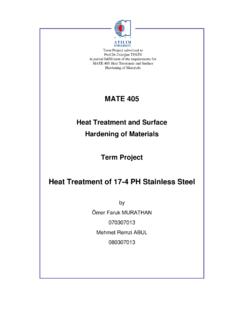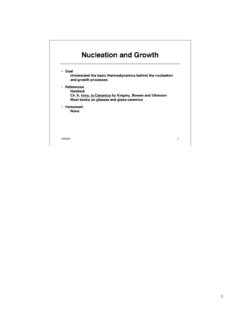Transcription of Mechanical Properties of 304L and 316L Austenitic ...
1 M3LW-16OR0402153 PNNL-25854 M3LW-16OR0402153 PNNL-25854 Light Water Reactor Sustainability Program Mechanical Properties of 304L and 316L Austenitic Stainless Steels after Thermal Aging for 1500 Hours Cast Stainless Steel Aging (LW-16OR040215) September 2016 Depart of Energy Office of Nuclear Energy M3LW-16OR0402153 PNNL-25854 i DISCLAIMER This information was prepared as an account of work sponsored by an agency of the Government. Neither the Government nor any agency thereof, nor any of their employees, makes any warranty, expressed or implied, or assumes any legal liability or responsibility for the accuracy, completeness, or usefulness, of any information, apparatus, product, or process disclosed, or represents that its use would not infringe privately owned rights.
2 References herein to any specific commercial product, process, or service by trade name, trade mark, manufacturer, or otherwise, does not necessarily constitute or imply its endorsement, recommendation, or favoring by the Government or any agency thereof. The views and opinions of authors expressed herein do not necessarily state or reflect those of the Government or any agency thereof. M3LW-16OR0402153 PNNL-25854 ii Department of Energy/Office of Nuclear Energy LWR Sustainability R&D Cast Stainless Steels Aging (WP#: LW-16OR040215) Mechanical Properties of 304L and 316L Austenitic Stainless Steels after Thermal Aging for 1500 Hours by Thak Sang Byun Timothy G.
3 Lach Pacific Northwest National Laboratory operated by Battelle for the Department of Energy under contract DE-AC05-76RL01830 M3LW-16OR0402153 PNNL-25854 iii Contents LIST OF TABLES AND FIGURES .. IV 1. EXECUTIVE SUMMARY .. 1 2. EXPERIMENTAL .. 2 MATERIALS: TWO REFERENCE Austenitic STAINLESS STEELS .. 2 TENSILE AND CHARPY IMPACT TESTING .. 2 3. TENSILE Properties AFTER 1500 H AGING .. 3 THERMAL AGING EFFECT ON STRENGTH .. 3 THERMAL AGING EFFECT ON DUCTILITY .. 5 4. IMPACT ENERGY AFTER 1500 H AGING .. 7 TEMPERATURE TRANSITION BEHAVIOR .. 7 UPPER SHELF ENERGY AND DUCTILE BRITTLE TRANSITION TEMPERATURE .. 10 5. CONCLUDING REMARKS .. 11 6. REFERENCES .. 12 7.
4 APPENDICES .. 14 GRAIN STRUCTURE AND ELEMENTAL DISTRIBUTION IN NON AGED CASS MATERIALS .. 14 PROGRESSES IN AGING AND CHARACTERIZATION .. 18 M3LW-16OR0402153 PNNL-25854 iv LIST OF TABLES AND FIGURES Table 1. Chemistries of model cast Austenitic stainless steels in 2 Figure 1. The effect of 1500 hour thermal aging on yield stress (YS) in 304L and 316L Austenitic stainless steels.. 4 Figure 2. The effect of 1500 hour thermal aging on ultimate tensile strength (UTS) in 304L and 316L Austenitic stainless steels.. 5 Figure 3. The effect of 1500 hour thermal aging on uniform elongation (UE) in 304L and 316L Austenitic stainless steels .. 6 Figure 4. The effect of 1500 hour thermal aging on total elongation (TE) in 304L and 316L Austenitic stainless steels.
5 7 Figure 5. Effect of 1500 hour thermal aging on temperature-transition behavior of Charpy impact energy in 304L Austenitic stainless steels.. 8 Figure 6. Effect of 1500 hour thermal aging on temperature-transition behavior of Charpy impact energy in 316L Austenitic stainless steels.. 9 Figure 7. Upper shelf energy of 304L and 316L stainless steels befor and after 1500 hour 10 Figure 8. Ductile-brittle transition temperature (DBTT) of 304L and 316L stainless steels befor and after 1500 hour aging .. 11 Figure A1: STEM-EDS map of CF3M / phase boundary. Ni enrichment in -austenite; Cr enrichment in -ferrite; Fe depletion at the boundary; and Mo segregation to the boundary with some enrichment in the -ferrite (a depletion region around the boundary is noticeable too).
6 14 Figure A2: TEM images showing dislocation structures and STEM-EDS map of / phase boundary for CF3 (top) and CF3M (bottom) alloys.. 15 Figure A3: TEM images showing dislocation structures and STEM-EDS map of / phase boundary for CF8 (top) and CF8M (bottom) alloys.. 16 Figure A4: EDS line scans for four primary elements across the ferrite-austenite phase boundary in four as-cast model CASS alloys. Blue-CF3, red-CF3M, black-CF8, yellow-CF8M. These data are all counts that have been adjusted to put elements together for comparison of the relative shapes of data. Absolute count values include errors.. 17 Table A1: Status of aging & characterization (black-complete/green-ongoing/blue-plann ed).
7 18 M3LW-16OR0402153 PNNL-25854 1 Mechanical Properties OF 304L AND 316L Austenitic STAINLESS STEELS AFTER THERMAL AGING FOR 1500 HOURS Byun and Lach Nuclear Sciences Division, Pacific Northwest National Laboratory, Richland, WA 99352 1. EXECUTIVE SUMMARY This report presents the Mechanical test data of 304L and 316L Austenitic stainless steels before and after thermal aging for 1500 hours. These alloys were selected as reference materials for comparison with the case Austenitic stainless steels (CASSs). The aging degradation of CASS components is an important concern in the extended operation of light water reactors (LWRs) not only because the aging phenomena beyond the reactor operating experiences are not fully understood, but also because replacement of such massive components would be prohibitively expensive [1,2].
8 The ongoing research, Cast Stainless Steel Aging, aims to expand scientific understanding on thermal-aging induced degradation phenomena, and ultimately, to provide knowledge-based conclusive prediction for the integrity of the CASS components of LWR power plants during the service life extended up to and beyond 60 years [3]. Most CASS materials used in nuclear power plants have a duplex structure of Austenitic ( ) matrix and 3 40% ferritic ( ) phase. It is known that any cast microstructure containing a significant amount (>20%) of -ferrite can become susceptible to the thermally-induced embrittlement in the reactor operating temperature range 280 340 C [1-6]. The primary brittle fracture mechanism observed in a thermally embrittled duplex stainless steel is cleavage initiation at ferrite followed by propagation through separation of ferrite-austenite phase boundary, and such cracking mechanism could be caused or enhanced by various microstructural changes during thermal aging, such as formation of a Cr rich '-phase through the spinodal decomposition of -ferrite, precipitation of G-phase and M23C6 carbide, and additional precipitation and growth of carbides and nitrides at ferrite-austenite phase boundaries [4-21].
9 It is known, however, that the precipitation of Cr rich '-phase in -ferrite is the main embrittlement mechanism in the cast stainless steels, while the thermal aging induces various precipitations in the austenite matrix but usually causes a negligible to moderate effect on the Properties of the phase [6-9]. These observations naturally lead to a prediction that the pure Austenitic stainless steels with similar chemistries as those of CASS alloys will not experience thermal embrittlement in comparable time periods. To obtain the reference data and compare with the thermally-induced changes in the cast Austenitic stainless steels, two fully Austenitic alloys ( , type 304L and 316L alloys) have been aged at 290 400 C for 1500 hours and characterized.
10 This report will describe the Mechanical property changes in 304L and 316L Austenitic stainless steels due to the shortest term (1500 h) thermal aging. In this report the uniaxial tensile test and Charpy impact test data comprise the key datasets used to discuss the effects of thermal aging. To obtain the tensile property data in each alloy and aging condition, seven SS-3 specimens with a gage section of mm were tested at a displacement rate of mm/min and at RT, 100, 200, 290, 330, 360, and 400 C, respectively. In the Charpy impact testing, meanwhile, twelve standard sized specimens, M3LW-16OR0402153 PNNL-25854 2 , V-notched bars of 10 10 55 mm, were tested at selected 12 temperatures ranging from liquid nitrogen temperature to 300 C.






